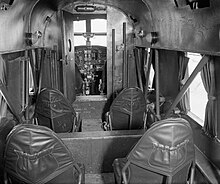Avro Anson
The type was placed into service with the Royal Air Force (RAF) and was initially used in the envisaged maritime reconnaissance operation alongside the larger flying boats.
Large numbers of the type were instead put to use as a multi-engine aircrew trainer, having been found to be suitable for the role, and became the mainstay of the British Commonwealth Air Training Plan.
In 1933, the British Air Ministry proposed that the Royal Air Force (RAF) acquire a relatively cheap landplane for coastal maritime reconnaissance duties; the proposed aircraft would perform as a supplement to the more capable, but expensive, flying boats which the RAF had adopted for conducting maritime reconnaissance missions.
[3] In response to its selection, Air Ministry Specification G.18/35 was written around the Type 652A; in July 1935, an initial order for 174 aircraft, which had been given the service name "Anson", was received.
[4] On 31 December 1935, the first production Anson performed its maiden flight; changes from the prototype included an enlarged horizontal tailplane and reduced elevator span in order to improve stability.
Additionally, while the prototype had not been fitted with flaps, production aircraft could accommodate their installation from the onset to increase the viable glide angle and reduce landing speed.
[6] By the end of production in 1952, a total of 11,020 Ansons had been completed, which made it the second most numerous (after approximately 11,500 Vickers Wellington medium bomber) British multi-engined aircraft of the Second World War.
Developed as a general reconnaissance aircraft, it possessed many features that lent itself to the role, including considerable load-carrying ability, and long range.
[8] The structure of the Anson was relatively straightforward and uncomplicated, relying on proven methods and robust construction to produce an airframe that minimized maintenance requirements.
The Anson Mk I was furnished with a low-mounted one-piece wooden wing, composed of a combination of plywood and spruce throughout the wingbox and ribs.
[8] The Anson was powered by a pair of Armstrong Siddeley Cheetah IX seven-cylinder air-cooled radial engines, which were each rated at 350 horsepower (260 kW).
[14] The bomb-aimer would perform his function from a prone position in the forward section of the nose, which was provisioned with a bombsight, driftsight, and other appropriate instrumentation, including a landing light.
Upon the type's introduction, it represented a new level of capability for the service, serving not only in a general reconnaissance capacity but also being an effective general-purpose aircraft[8] In July 1937, a Coastal Command Anson was fitted with an experimental airborne early warning radar which was able to detect large warships 5 miles (8.0 km) away in poor visibility and was successfully used in fleet exercises off the east coast of England in September.
After training the crews would advance to the frontline bomber squadrons with aircraft such as the Fairey Battle, Bristol Blenheim, Vickers Wellington, Armstrong Whitworth Whitley or Handley-Page Hampden.
Even before the start of the war, it had been realized that the Anson's limited capabilities would make it ineffective in its intended main role as a maritime patrol aircraft.
In 1938, it had been decided to replace the Anson in this role with the American-built Lockheed Hudson, which was 100 mph faster, had three times the range, carried a much heavier bomb load and had a superior defensive armament.
The Anson had an endurance of only four hours so it could only be employed in the North Sea and other coastal areas; however, it lacked the range to reach the coast of Norway.
Its weapons against German U-boats were two small 100 lb bombs, which required a direct hit on the hull of a submarine to be effective, at least in theory.
On 3 December 1939, an Anson mistakenly attacked a surfaced Royal Navy submarine, HMS Snapper, and although the aircraft succeeded in hitting the conning tower, the only damage was four broken light bulbs.
233 Squadron had bounced off the surface of the water and exploded in an air burst, which holed the aircraft's fuel tanks causing it to ditch off St Andrews.
[19] Despite numerous claims of attacks on U-boats by Ansons in the first months of the war, postwar examination of German records showed that little damage had been inflicted.
[citation needed] Despite their obsolescence, Ansons were employed during the Dunkirk evacuation to deter attacks on Allied shipping by German E-boats.
[24] The Royal Australian Air Force (RAAF) initially ordered 33 Ansons in November 1935 to fill the maritime reconnaissance role.
A good example of the training schools' involvement in combat operations with the EAC during the emergency of the battle is illustrated in an article dated 1 March 2006 of the Royal Canadian Legion magazine entitled Eastern Air Command: Air Force, Part 14; the author Hugh A. Haliday wrote: "The need for Atlantic patrols was undiminished, yet the Battle of the St. Lawrence stretched EAC resources.
[29] Ansons continued to be manufactured by Avro at Woodford for the RAF until March 1952; the type was used as trainers and served in the role of Station communications aircraft until 1968.












